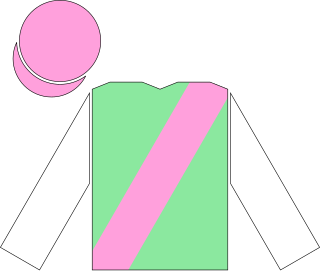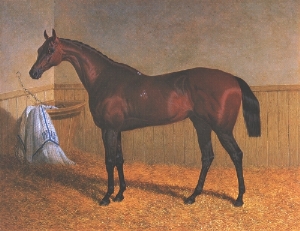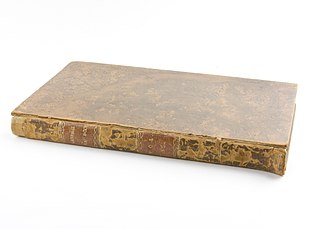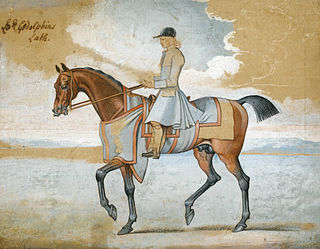Related Research Articles

Danehill was an American-bred, British-trained Thoroughbred racehorse who was the most successful sire of all time with 349 stakes winners and 89 Grade 1 winners. He was the leading sire in Australia nine times, the leading sire in Great Britain and Ireland three times and the leading sire in France twice.

Beeswing (1833–1854) was a 19th-century British Thoroughbred racehorse from the north of England. In her day, Beeswing was hailed as the greatest mare in Britain and one of the greatest of all time.

Diomed was an English Thoroughbred race horse who won the inaugural running of the Epsom Derby in 1780. Sold and imported to Virginia, he was subsequently a successful sire in the United States after the American Revolutionary War.
Danzig was an American Thoroughbred racehorse who is best known as a leading sire. He was purchased for $310,000 by Henryk de Kwiatkowski at the 1978 Saratoga Yearling Sale. The son of Hall of Famer Northern Dancer and the most commercially successful sire of the second half of the 20th century, he won all three of his races before knee problems ended his racing career.

Cade (1734–1756) was an important foundation sire of Thoroughbred racehorses. He was the Leading sire in Great Britain and Ireland in 1752, 1753, 1758, 1759 and 1760.

Regulus (1739) was an undefeated British Thoroughbred racehorse who won eight Royal Plates in 1745.

Sir Archy was an American Thoroughbred racehorse considered one of the best racehorses of his time and later one of the most important sires in American history. He was inducted into the National Museum of Racing and Hall of Fame in the inaugural class of 1955.

Thoroughbred breeding theories are used by horse breeders in an attempt to arrange matings that produce progeny successful in horse racing. Bloodstock experts also rely on these theories when purchasing young horses or breeding stock. A basic understanding of these theories can also help the racing public understand a horse's theoretical genetic potential. The breeding theories stem from the belief that careful analysis of bloodlines can lend predictability to breeding outcomes. A well-designed mating increases the probability of the offspring's success, although many other factors also come into play.
No Class was a Canadian Hall of Fame Thoroughbred racehorse.

Star Shoot was a Thoroughbred racehorse that was bred in Ireland, raced in the United Kingdom and was eventually imported to the United States to become a five-time leading sire in the early 1900s. He was a white stockinged, chestnut colt sired by the great British 1893 Triple Crown winner, Isinglass, out of the Hermit bred mare Astrology. He is best remembered for siring the American Classic winning sons Sir Barton and Grey Lag and the 1917 American Oaks winning filly Wistful I.
Ditto (1800–1821) was a British Thoroughbred racehorse and sire. During a racing career that lasted from May 1803 to April 1807 he was lightly campaigned, running six times in five seasons and winning four races. In the summer of 1803 he proved himself one of the best British colts of his generation, by winning Derby on his only appearance on the season. He went on to win two important races at Newmarket and a King's Plate at Guildford. Ditto was retired to stud in 1808 and had some success as a sire of winners.
Aimwell was a British Thoroughbred racehorse. In a career that lasted from autumn 1784 to spring 1786, he ran eight times and won five races. In 1785, he won the sixth running of the Epsom Derby as well as three races at Newmarket. He was beaten in his only race in 1786, and did not appear in any subsequent records.
Noble was a British Thoroughbred racehorse and sire. In a career that lasted from May 1786 to May 1788 he ran at least three times and won two races. He won the seventh running of The Derby as a 30/1 outsider in what was probably his first race. His only other success came at Newmarket later that year. He was retired to stud where he stood as a stallion for several years but made little impact as a sire of winners.

Snap was a Thoroughbred racehorse who won all four of his races. After retiring from racing he became a successful stallion. He was Champion sire four times and his progeny included the undefeated Goldfinder.

Bay Bolton or Brown Lusty (1705–1736) was a British Thoroughbred racehorse who won Queen Anne's Gold Cup as a five-year-old in 1710. After retiring from racing he became a successful sire for the Charles Paulet, 2nd Duke of Bolton, and his son Charles Powlett, 3rd Duke of Bolton, was Champion sire seven times.

Cobweb (1821–1848) was an undefeated British Thoroughbred racehorse and who won two British Classic Races as a three-year-old and went on to become a highly successful broodmare. Cobweb's racing career consisted of three competitive races in the early part of 1824. After winning on her debut she claimed a second prize when her opponents were withdrawn by their owners. She then won the 1000 Guineas at Newmarket Racecourse and the Oaks Stakes at Epsom Downs Racecourse before being retired to stud.
Blank (1740–1770) was a British Thoroughbred racehorse and sire. He only won one race, but became a very successful sire and was British Champion sire in 1762, 1764 and 1770.
Bloody Buttocks was a British Thoroughbred sire who was the leading sire in Great Britain and Ireland in 1739. He was owned by Mr. Crofts.

Lath was a British Thoroughbred racehorse. He won at least four races, including a 1000-guinea sweepstakes at Newmarket and a match race against Squirt. After retiring from racing he became a stallion and produced a number of high-class runners and also sired the grand-dam of St. Leger winner Hollandoise.
Squirt was a Thoroughbred racehorse, best known as the grandsire of Eclipse, founder of the breed's dominant sire line. He lived at a time when the Thoroughbred breed was in its infancy, before even the foundation of the Jockey Club and General Stud Book. Thus information is incomplete.
References
- 1 2 3 "Early Studbook". Bloodlines.net. Retrieved 2012-12-02.
- 1 2 Pick, William; Johnson, R. (1803). The Turf Register (Volume I). A. Bartholoman, High-Ousegate.
- ↑ "Thoroughbred Foundation Sires". Tbheritage.com. Retrieved 2012-12-02.
- ↑ Historic Sire Lines